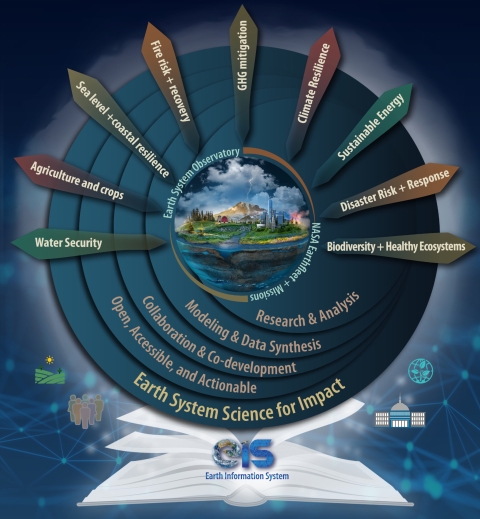The following datasets, housed on the VEDA Dashboard, explore key indicators to track and compare changes over time:
Dataset: Projections of Changes to Winter Precipitation
Summary: CMIP6 projections of changes to winter cumulative precipitation
Topic: Water Security
Dataset: Projections of Changes to Winter Temperature
Summary: CMIP6 projections of changes to winter average air temperature
Topic: Water Security
Dataset: Land Cover—Bangladesh
Summary: Annual land cover maps for 2001 and 2020 (Bangladesh)
Topics: Water Security, Sea Level Change and Coastal Risk, and Agriculture
Dataset: Burn Area Reflectance Classification for Thomas Fire
Summary: Burn Area Reflectance Classification (BARC) from the Burned Area Emergency Response (BAER) program for the Thomas Fire of 2017
Topics: Fires, Water Security
Dataset: Caldor Fire Behavior and Burn Severity
Summary: Progression and active fire behavior of the 2021 Caldor Fire in California
Topics: Fires, Water Security
Dataset: Stream Network Across the Contiguous United States
Summary: Stream network across the contiguous United States delineated using the Soil and Water Assessment Tool
Topic: Water Security
Dataset: DisALEXI ET Suppression
Summary: Change in evapotranspiration (ET) using DisALEXI model of OpenET observations for 2017 to 2020 fires, calculated as the difference of ET in the immediate post-fire water year from ET in the immediate pre-fire water year
Topics: Fires, Water Security
Dataset: ECCO Sea Surface Height Change from 1992 to 2017
Summary: Gridded global sea-surface height change from 1992 to 2017 from the Estimating the Circulation and Climate of the Ocean (ECCO) ocean state estimate
Topics: Sea Level Change and Coastal Risk
Dataset: Maximum Fire Radiative Power for Thomas Fire
Summary: Maximum Fire Radiative Power recorded by the Visible Infrared Imaging Radiometer Suite (VIIRS) instrument aboard the Suomi National Polar-orbiting Partnership (Suomi NPP) satellite per 12-hour fire line segment for the Thomas Fire of 2017
Topics: Fires, Water Security
Dataset: A Global Reanalysis for Water, Energy, and Carbon Cycle Variables
Summary: High-resolution (10 km) global data product that integrates NASA’s state-of-the-art model with satellite observations
Topic: Water Security
Dataset: LIS Modeled ET Suppression
Summary: Change in ET for 2020 fires using Land Information System (LIS) outputs
Topics: Fires, Water Security
Dataset: LIS Modeled Transpiration Suppression
Summary: Change in Transpiration for 2020 fires using LIS outputs
Topics: Fires, Water Security
Dataset: Global Water Cycle Reanalysis Trends
Summary: Trend in Terrestrial Water Storage (TWS) and Gross Primary Production (GPP) modeled using data assimilation within the LIS framework
Topic: Water Security
Dataset: MTBS Burn Severity
Summary: Burn severities and extents of fires from the Monitoring Trends in Burn Severity (MTBS) program from 2016 to 2020
Topics: Fires, Water Security
Dataset: Projections of Snow Water Equivalent Losses
Summary: Percent change to future snow water equivalent modeled using the LIS framework and CMIP6 projections
Topic: Water Security
Dataset: Projections of Snow Water Equivalent
Summary: Snow water equivalent modeled using the LIS framework and CMIP6 projections
Topic: Water Security
Dataset: SPoRT Land Information System
Summary: SPoRT’s real-time instance of the LIS provides low-latency soil moisture analyses provided by the Short-term Prediction Research and Transition Center Land Information System (SPoRT-LIS)
Topics: Water Security, Agriculture
Dataset: Terrestrial Water Storage Anomalies
Summary: TWS anomalies modeled using data assimilation within the LIS framework
Topic: Water Security
Dataset: Global TWS Non-Stationarity Index
Summary: The global TWS non-stationarity index integrates the trend, seasonal shifts, and variability change of TWS from 2003 to 2020
Topic: Water Security
Dataset: Terrestrial Water Storage Trend
Summary: Trend in TWS anomalies modeled using data assimilation within the LIS framework
Topic: Water Security






